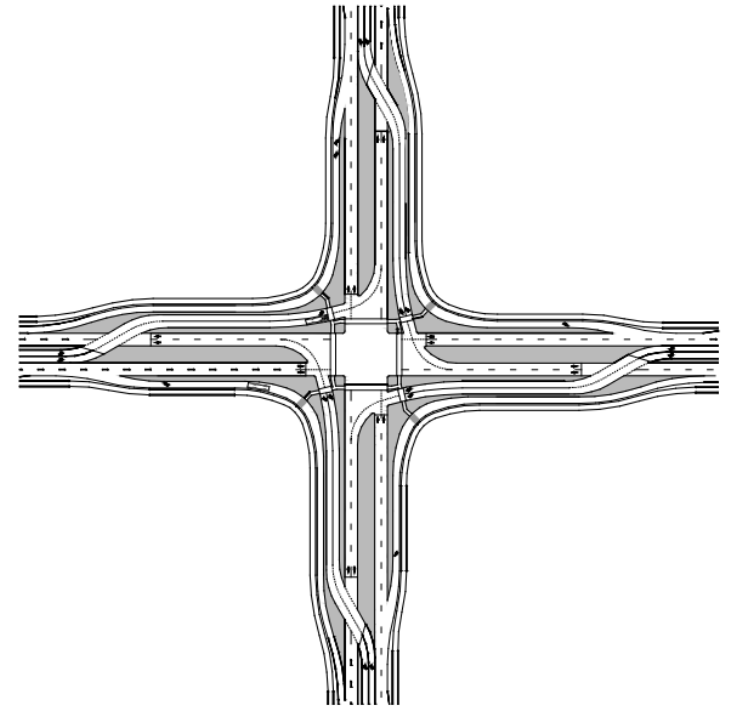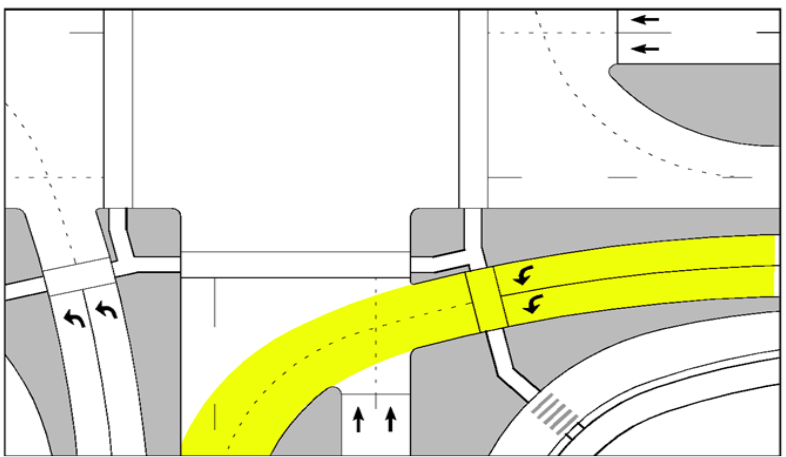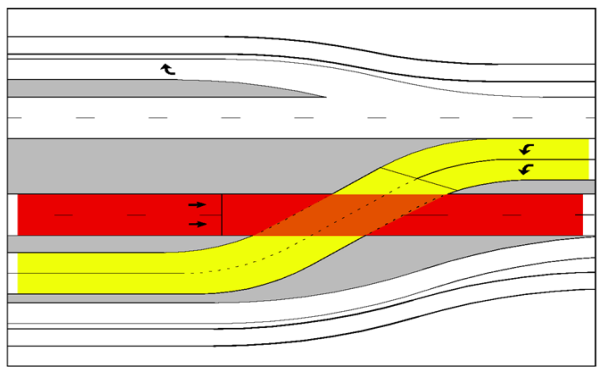14.7 Displaced Left-Turn Intersection (DLT)
14.7.1 Overview
The DLT, also known as a continuous flow intersection (CFI), is an intersection that relocates one or more left-turn movements on an approach to the other side of the opposing traffic flow. This allows left-turn movements to proceed simultaneously with the through movements and eliminates the left-turn phase for this approach.
TxDOT has adopted the
as the primary source for DLT Guidelines along with TxDOT’s
.The information contained in this section is considered a companion guide and is intended to document TxDOT’s suggested approach to DLT design. See
for a typical four-legged DLT with displaced lefts on a major street.

Figure 14-24: Four-legged DLT with Displaced Lefts on a Major Street
Source: VDOT
Benefits of a DLT include a reduction in the number of signal phases with a resultant increase in vehicle throughput. See
for an example of a DLT Intersection with displaced left-turns on all approaches. Conditions where a DLT may not be suitable are:
- Areas with limited ROW, due to the large footprint required for a DLT;
- Where there is a lack of driver familiarity and no driver education is provided; and
- Intersections with nearby adjacent driveways.

Figure 14-25: DLT Intersection with Displaced Left-Turns on All Approaches
Source: FHWA DLT Informational Guide
14.7.2 Design Considerations
The distance between the main intersection and the crossovers should generally range from 300-ft to 500-ft. Shorter spacing may result in queue spillback and reduce the ability to clear queues through a single signal cycle phase. Longer spacing may result in greater difficulty in coordinating signal operations. See
for a depiction of typical intersection spacing.

Figure 14-26: DLT Typical Intersection Spacing
Source: FHWA DLT Informational Guide
At the main intersection, the primary objective is to provide appropriate turning paths for the displaced left-turns, considering the interaction with sidewalks. Side-by-side check vehicles are not typically accommodated but can be if the context of the intersection has a high frequency use of check vehicles. The vehicle paths for the displaced left-turns through the main intersection will delineate the curb lines and stop bar (a.k.a. stop line) locations and determine the width of the overall intersection as shown in
.

Figure 14-27: DLT Left-Turn Maneuvers
Source: FHWA DLT Informational Guide
For the crossover intersection, the main objective is to provide a smooth alignment for the traffic and not introduce back-to-back reverse curves along the travel paths. The goal is to align the left-turns at the stop bar with the receiving lanes to reflect desirable vehicle path alignment to minimize path overlap as shown in
.
It is desirable to provide the largest crossing angle while adapting to each site’s unique conditions. Early design practice targeted crossover angles of 45 degrees or greater to facilitate proper vehicle path alignment through the crossover and reduce the likelihood of wrong-way movements. It is often difficult to achieve 45 degrees in practice. Several factors influence cross angle selection:
- Wrong-way maneuvers —Minimizing the likelihood of a wrong-way maneuver into opposing traffic is a key consideration. The greater the crossing angle, the more the intersection will appear conventional and support use of the crossover; and
- ROW constraints —The surrounding environment will influence a configuration. For instance, a retrofit design may be constrained by ROW.

Figure 14-28: DLT Crossover Intersection Geometry
Source: FHWA DLT Informational Guide
Additionally, there are two ways to accommodate the geometry where the right-turn bypass lane joins the crossroad through lanes:
- Provide an additional lane with a downstream merge; or
- Signalize the movement and operate it as part of the crossover signal.
For more detailed information on the geometric design of a DLT intersection refer to Chapter 7 of the
, Sight Distance.
Provide appropriate sight distance and lighting for approaching motorists to see activity at the crosswalk, as well as sight distance for pedestrians to see oncoming traffic. Stopping sight distance for the approaching motorists and sight distances for the pedestrians approaching the potential oncoming automobiles must be clear of obstructions and provide sufficient visibility for various users.
14.7.3 Pedestrian and Bicyclist Considerations
Crosswalks for DLTs are at the same locations that they would be for a conventional intersection. The major street crossing may be made in one or two stages, where the median can be used to provide a refuge for a two-stage crossing.
shows a typical pedestrian crossing with refuge islands.

Figure 14-29: Refuge Islands Between Left-Turn and Through Lanes
Source: FHWA DLT Informational Guide
Various options exist for bicyclists to safely use a DLT. Where on-street bicycle lanes are provided on a corridor, they should continue through the DLT intersection. Marked "bike box" locations should be provided for left-turns. Since less experienced cyclists may not feel comfortable riding through the DLT, it is desirable to provide a ramp from the bike lane to a shared-use path which can be used by both pedestrians and cyclists. This is similar to the recommended practice at roundabouts.
Ultimately, a thorough site assessment, an assessment of anticipated bicycle and pedestrian volumes, and an assessment of projected origins and destinations for pedestrians and bicyclists should be conducted to determine the preferred method of movement through the DLT.
14.7.4 Access Management
Maintaining or providing access to homes and businesses near a DLT intersection can be accomplished by using frontage roads; however, weaving movements in and out of driveways or a need for U-turns at the main or adjacent intersections may result in conflict. DLT intersection implementation typically restricts access to parcels situated in the quadrants of the main intersection. Access to these parcels can be accommodated via right-in/right out configurations from the channelized right-turn lanes. Refer to the
for additional guidance for access management for DLT intersections.
14.7.5 Safety
DLT intersections provide safety benefits due to the reduction of conflict points within the intersection. Safety issues to consider with displaced left-turn intersections include:
- Pedestrian and bicycle conflicts;
- Potential for wrong-way movements; and
- Potential impact on emergency vehicle response times in the event that the intersection is blocked or there has been a loss of power to the signal.
For additional information on safety, refer to the
.
14.7.6 Operations
DLT intersections can improve traffic flow by separating left-turning vehicles from through traffic. The DLT is a system of multiple signalized intersections. Signal timing and phasing are critical to the performance of a DLT intersection. Right-turns on red are prohibited as shown in
.
.png/_jcr_content/renditions/original)
Figure 14-30: Example Continuous Flow Intersection (DLT)
Source: TxDOT
14.7.7 Traffic Control Devices
DLT intersections require clear traffic control devices to guide drivers through the intersection. The main objectives of traffic control devices in DLT intersections are:
- Position signal heads above the receiving lanes at the crossovers;
- Provide signage and pavement markings to prohibit wrong-way movements;
- Provide lane extension striping through the main crossover intersection; and
- Provide pavement markings and overhead signs as supplemental guidance.
Refer to the
for more information on traffic control devices at DLTs. The
remains the primary source for traffic control device standards.